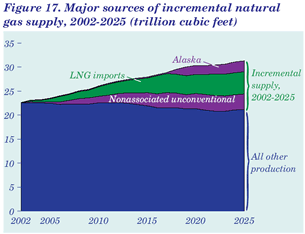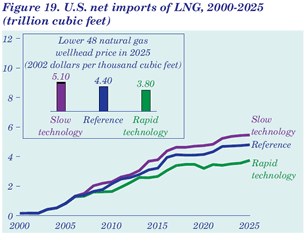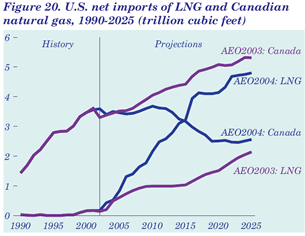|
Issues In Focus. Reassessment of Liquefied Natural Gas Supply Potential Interest in liquefied natural gas (LNG) as a source for fuel supply in the United States has been rekindled and strengthened as a result of sustained high natural gas prices, declining costs throughout the LNG supply chain (production, liquefaction, transportation, and regasification), and recent regulatory changes (see “Legislation and Regulations”). During the winter of 2000-2001—a colder winter than normal—natural gas prices on the domestic spot market climbed above $10.00 per thousand cubic feet, and the average wellhead price increased to $6.82 per thousand cubic feet in January 2001. At that time, plans were announced for the reopening of mothballed LNG terminals in Maryland (Cove Point) and Georgia (Elba Island), and plans for the construction of additional new facilities were being discussed. By July 2001, wellhead natural gas prices had dropped below $3.50 per thousand cubic feet, where they remained for most of 2002. Interest persisted in LNG, which generally was thought to be economical in the price range of $3.50 to $4.00 per thousand cubic feet, but momentum slowed as investors waited cautiously to see whether prices would remain below $3.50. In late 2002, average wellhead prices again began to rise, to $3.59 per thousand cubic feet in November and $3.84 in December. They have remained well above $4.00 per thousand cubic feet since then. Average wellhead prices for the first half of 2003 ranged from a low of $4.47 per thousand cubic feet in January to a high of $6.69 in March, contributing to the belief that there has been a fundamental upward shift in natural gas prices. LNG imports are expected to constitute an increasing proportion of U.S. natural gas supply (Figure 17). Total net imports are projected to supply 21 percent of total U.S. natural gas consumption in 2010 (5.5 trillion cubic feet) and 23 percent in 2025 (7.2 trillion cubic feet), compared with recent historical levels of around 15 percent. Nearly all of the increase in net imports, from 3.5 trillion cubic feet in 2002, is expected to consist of LNG. LNG imports already have doubled from 2002 to 2003, based on preliminary estimates that show LNG gross imports at 540 billion cubic feet in 2003, compared with 228 billion cubic feet in 2002. Strong growth in LNG is expected to continue throughout the forecast period, with LNG’s share of net imports growing from less than 5 percent in 2002 to 39 percent (2.2 trillion cubic feet) in 2010 and 66 percent (4.8 trillion cubic feet) in 2025. In the AEO2004 forecast, four new LNG terminals are expected to open on the Atlantic and Gulf Coasts between 2007 and 2010. The first new LNG terminal in more than 20 years is projected to open on the Gulf Coast in 2007. Although the actual sizes of the new plants will vary, for projection purposes a generic size of 1 billion cubic feet per day is used in AEO2004 for new facilities on the Gulf Coast and 250 to 500 million cubic feet per day elsewhere. One facility, expected to serve Florida, is planned for construction in the Bahama Islands, with the gas to be transported through an underwater pipeline to Florida. Existing U.S. LNG plants are expected to be at, or close to, full capacity by 2007, importing 1.4 trillion cubic feet annually, and new plants are projected to import a total of 812 billion cubic feet in 2010. In addition, a new terminal in Baja California, Mexico, is expected to start moving gas into Southern California in 2007, with volumes reaching 180 billion cubic feet by 2008. Additional capacity in Baja California is expected to be added in 2012, increasing annual deliveries into Southern California to 370 billion cubic feet per year from 2014 through 2025. Other new terminals are expected to be constructed in the Mid-Atlantic and New England regions by 2016, and significant additional capacity is expected along the Gulf Coast by 2025, including expansions of existing terminals and construction of new ones. Imports into new Gulf Coast terminals are projected to total nearly 2.5 trillion cubic feet in 2025. It is considerably more expensive to build LNG regasification plants at new U.S. sites than to expand capacity at existing sites. In addition, LNG delivered to new sites can be expected to have higher production and shipping costs if it is obtained from new, potentially more distant and expensive supply sources. Delays and regulatory costs are also expected to add to the price of gas for new facilities. As a result, “trigger prices” for the construction of new LNG plants are estimated currently at $3.62 to $4.58 per million Btu, compared with less than $2.87 to $3.15 per million Btu for expansion at existing plants. With changing market conditions, most forecasters now expect LNG to become an increasingly important source of incremental natural gas supply for the United States. As of August 2002, there were 16 active proposals to construct new LNG regasification terminals in North America to serve U.S. markets (or partially serve, as in the case of three proposed terminals in Baja California, Mexico), with total annual capacity slightly over 5 trillion cubic feet.
As of December 1, 2003, there were 32 active proposals for new terminals (Table 12): 21 in the United States, 4 in Baja California, Mexico (to serve both Mexico and U.S. markets), 2 in Mexico, 3 in the Bahamas (to serve U.S. markets), and 2 in Canada (to serve Canada and possibly also U.S. markets). The increase in proposed capacity between August 2002 and October 2003 includes both additional terminals and increases in capacity for many of those previously proposed. Proposed projects active during the summer of 2002 were primarily for terminals with a capacity of 1 billion cubic feet per day or less, whereas 9 of the current proposals are for terminals with a capacity of 1 to 2 billion cubic feet per day. If all the U.S. LNG facilities currently being proposed were completed, they would add more than 15 trillion cubic feet to annual U.S. import capacity. In addition, two proposed terminals in Mexico to serve Southern Mexican markets would have the indirect affect of reducing U.S. natural gas exports to Mexico. Three proposals to construct terminals in the onshore Gulf of Mexico have been filed with the U.S. Federal Energy Regulatory Commission, and one, Cameron LNG (formerly Hackberry), has received preliminary approval (see “Legislation and Regulations”). Two more proposals for the offshore Gulf of Mexico have been filed with the U.S. Coast Guard. Despite this strong activity, proposals for new capacity involve significant risk and uncertainty, and not all are expected to move forward. The delivery of new LNG supplies to a new U.S. regasification facility requires the financing, permitting, and construction of at least four expensive infrastructure components: gas production and processing facilities in a source country; an LNG liquefaction plant and export terminal; LNG transport tankers; and the LNG regasification and import terminal in the destination country. Additional pipeline capacity—either to the liquefaction plant or away from the regasification facility—might also be needed. If any aspect of the infrastructure chain is delayed by permitting, financing, or construction problems, the potential profitability of the endeavor could be significantly diminished. Delays in the eventual commissioning of a new LNG supply chain ending in the United States could occur for a number of reasons:
Global developments are also contributing to the domestic emphasis on LNG, as new liquefaction facilities proliferate around the world and potential supply sources expand. Until 1995, almost all U.S. LNG imports were from Algeria. More recently, shipments have also been received from Nigeria, the United Arab Emirates, Oman, Qatar, Malaysia, Australia, and Trinidad and Tobago. Additional sources of supply exist throughout the world where liquefaction facilities are either being developed or are in the planning stages. Current worldwide liquefaction capacity and LNG consumption are roughly equivalent at slightly over 6 trillion cubic feet per year, indicating that supply constraints are contributing to the current underutilization of U.S. regasification capacity. The equivalency of capacity and consumption is changing, however, with an additional annual capacity of 2 trillion cubic feet under construction and scheduled to come on line by 2006 and an additional 8.5 trillion cubic feet of capacity planned to come on line by 2011. Trinidad and Tobago, with current annual capacity of approximately 300 billion cubic feet, has now surpassed Algeria as the primary source of supply for U.S. markets. With an additional 157 billion cubic feet scheduled to come on line by 2006 and 570 billion cubic feet under consideration for development by 2011, Trinidad and Tobago (located in relative proximity to the U.S.) is an important player in the future growth of the U.S. LNG market. As the global market evolves, LNG is becoming an increasingly important energy source for many countries. A number of European and Asian nations already rely heavily on LNG. Japan, in particular, depends on LNG to meet its power generation needs. As the world market for LNG continues to expand, natural gas is expected to become more of a global commodity, and the world natural gas market is expected to affect the U.S. market [47]. An important aspect of globalization is expansion of the LNG spot market. Internationally, most LNG currently is traded under long-term contracts. In recent years, however, the short-term market has played a more significant role, especially in the United States (Figure 18). Most of the LNG imported at the Everett terminal in Massachusetts remains under long-term contract at relatively stable quantities, but short-term deliveries at Lake Charles, Louisiana, have risen and fallen dramatically over the past few years, primarily in response to domestic natural gas prices. In 2002, all cargoes into Lake Charles were delivered under short-term contracts. Recent developments in Japan and South Korea illustrate the potential impact of global developments on the U.S. LNG market. In Japan, the forced closing of more than a dozen nuclear reactors in 2001 and 2002 because of reporting discrepancies led to greater reliance on fossil fuels for electricity generation. The result was a significant increase in Japan’s demand for LNG, so that the majority of world spot cargoes were delivered to the Japanese market. Japan’s increased reliance on LNG probably contributed to the reduction in short-term deliveries of LNG to the United States during the winter of 2001-2002, although low natural gas prices also played a role. In South Korea, an unusually cold winter in 2002-2003 led to the diversion of many spot cargoes to that country to meet unusually high demand for heating. The increase in shipments to South Korea may in part explain the low level of U.S. LNG imports during the winter of 2002-2003, when natural gas spot prices were spiking. These examples suggest that an assessment of future U.S. LNG consumption patterns cannot be based solely on the economics of the U.S. natural gas market.
In the United States, an important factor in the future growth of LNG imports is natural gas market prices. The potential impact of U.S. natural gas prices on LNG imports is illustrated by two AEO2004 sensitivity cases, the rapid and slow technology cases (Figure 19). The rapid and slow technology cases are used to assess the sensitivity of the projections to changes in assumed rates of progress for oil and natural gas supply technologies. To create the cases, reference case parameters for the effects of technological progress on finding rates, drilling activity, lease equipment and operating costs, and success rates for conventional oil and natural gas wells were adjusted by plus or minus 50 percent. Parameters for a number of key exploration and production technologies for unconventional gas were also adjusted by plus or minus 50 percent, and key parameters for Canadian supply were also adjusted to simulate the assumed impacts of rapid and slow oil and gas technology penetration on Canadian supply potential. In the projections for 2010, natural gas wellhead prices range from $3.25 per thousand cubic feet (2002 dollars) in the rapid technology case to $3.58 in the slow technology case; and in the 2025 projections, the prices range from $3.80 in the rapid technology case to $5.10 in the slow technology case. The volume of LNG imports across the rapid and slow technology cases varies from 1.6 trillion cubic feet to 2.3 trillion cubic feet, respectively, in 2010 and from 3.8 to 5.5 trillion cubic feet in 2025, compared with 0.2 trillion cubic feet in 2002. Reassessment of Canadian Natural Gas Supply Potential Until recently, Canada was expected to remain the primary source of natural gas imports for the United States through 2025, as projected in AEO2003; however, the AEO2004 reference case projects that net imports of LNG will exceed net imports from Canada by 2015 (Figure 20). The primary reason for the change in the AEO2004 forecast is a significant downward reassessment by the Canadian National Energy Board (NEB) of expected natural gas production in Canada. Both the NEB and the NPC have revised their earlier estimates of total Canadian natural gas production [48]. In 1999, NEB estimated total production in Canada in a range of 8.1 to 9.0 trillion cubic feet in 2015 and 7.7 to 9.9 trillion cubic feet in 2025. In contrast, NEB’s 2003 estimates show 5.9 to 7.1 trillion cubic feet in 2015 and 4.3 to 6.1 trillion cubic feet in 2025. NPC’s 1999 estimate for Canadian production in 2015 was 8.2 trillion cubic feet (no estimate was given for 2025). In 2003, NPC estimated a range of 6.4 to 7.0 trillion cubic feet for 2015 and 5.8 to 6.9 trillion cubic feet for 2025. Other reasons are declining natural gas production in the province of Alberta, which accounts for more than 75 percent of Canada’s natural gas production, and increasing use of natural gas for oil sands production. In its most recent annual reserve report, the Alberta Energy and Utilities Board expects gas production in the province to decline at an average rate of 2 percent per year between 2003 and 2012, while its oil sands production could triple. Because natural gas is one of the fuels used in producing oil sands (see below, “Natural Gas Consumption in Canadian Oil Sands Production”), such a dramatic increase could divert significant amounts of gas from the U.S. import market. Additional factors that could contribute to a decline in Canadian gas exports include higher projections for domestic natural gas demand in Canada and recent disappointments in Canadian drilling results, including smaller discoveries with lower initial production rates and faster decline rates. Two recent and significant drilling disappointments occurred in northeastern British Columbia’s Ladyfern field and the Scotian Shelf Deep Panuke field. Production from the Ladyfern field, heralded as Canada’s largest find in 15 years, peaked at 700 million cubic feet per day in 2002 and is declining rapidly. Current production is about 300 million cubic feet per day, and many expect the field to be depleted by the end of 2004. In February 2003, EnCana, initially highly optimistic about the Deep Panuke field, requested that the regulatory approval process for developing the field be placed on hold while it reassesses the economics of development. The AEO2004 forecast expects the decline in Canadian imports to be mitigated partially by the construction of a pipeline to move MacKenzie Delta gas into Alberta. Initial flows from the pipeline are expected in 2009, with annual throughput reaching approximately 675 billion cubic feet in 2012 and remaining at that level through 2025. .
Released: January 2004 |
||||||||||||||||||||||||||||||||||||||||||||||||||||||||||||||||||||||||||||||||||||||||||||||||||||||||||||||||||||||||||||||||||||||||||||||||||||||||||||||||||||||||||||||||||||||||||||||




